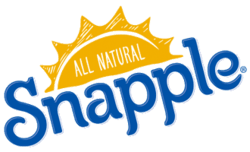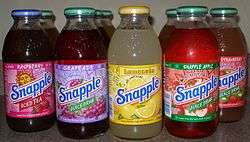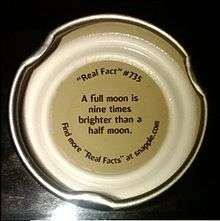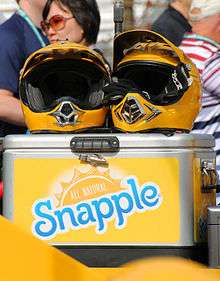Snapple
 | |
| Type | Iced tea, juice drink, lemonade, water |
|---|---|
| Manufacturer | Dr Pepper Snapple Group |
| Country of origin | United States |
| Introduced | 1980 |
| Website |
www |
Snapple is a brand of tea and juice drinks which is owned by Dr Pepper Snapple Group and based in Plano, Texas. The company (and brand), which was originally known as Unadulterated Food Products, was founded in 1972. The brand achieved some fame due to various pop-culture references including television shows.
History

Snapple was founded by Leonard Marsh, Hyman Golden, and Arnold Greenberg in 1972 in East Meadow, Long Island, New York.[1] Their company, which was originally known as Unadulterated Food Products, was first conceived as a part-time venture to supply fruit juices to health food stores.[2] Unsure if the business would succeed, Greenberg continued to run his health food store in Manhattan's East Village, while Leonard Marsh and his brother-in-law, Hyman Golden, operated a window washing business.[2] In a 1989 interview with Crain's New York Business, Marsh admitted that when they launched the small business he knew "as much about juice as about making an atom bomb."[2]
Unadulterated Food Products was one of the first companies in the United States to manufacture juices and other beverages made from natural ingredients.[2]
An early apple juice product led to the company's name, Snapple.[2] Golden, Greenberg and Marsh had created a carbonated apple juice.[2] Unfortunately, one of the batches of apple juice fermented in the bottle, causing the bottle caps to fly off.[2] The original name of that particular apple juice product, "Snapple," which derived from the words "snappy" and "apple," became the new name for their beverage company, the Snapple Beverage Corporation, beginning in the early 1980s.[2][3] Snapple would not manufacture their first tea, lemon tea, until 1987.[4]
Currently, there are four different types of Snapple: Tea (diet and regular), juice drinks, lemonade, and bottled water. Snapple is also bottled in the form of an aluminum can.[5]
Snapple's brand slogan is "Made from the Best Stuff on Earth."
Snapple was known for a popular series of TV advertisements in the early 1990s featuring Wendy Kaufman (the "Snapple Lady") answering letters from Snapple fans.[6] In an effort to counteract the Coke and Pepsi challenge commercials, Snapple began running a new line of advertisements in May 1992, which featured its trademark “made from the best stuff on earth” line in ads that spoofed earlier beer and sports drinks promotions; the ads received low marks from advertising industry observers. In addition, the company used its $15-million-a-year advertising budget to pay for a long-lived series of live radio commercials featuring controversial disk jockeys Howard Stern and Rush Limbaugh. At the end of the summer of 1992, Snapple conducted a five-week search for a new advertising agency that could better convey its corporate identity in preparation for a wider national push. Later that year, Snapple also signed tennis player Jennifer Capriati to endorse its products. By August 1992, Snapple had expanded its distribution to every major city in the United States and it signed new contracts with beverage distributors. The company owned no manufacturing facilities, but instead made agreements with more than 30 bottlers across the country. In this way, Snapple was able to keep its overhead low and its payroll short. The company administration consisted of just 80 employees, 50 of whom worked out of a modest office building on Long Island.[7]
The Quaker Oats Company bought Snapple for $1.7 billion in 1994.[8] The company ran into problems and sold it to Triarc in 1997 for $300 million.[9] Triarc sold it to Cadbury Schweppes for $1.45 billion in September 2000.[10] It was spun off in May 2008 to its current owners.

Starting in May 2009, Snapple was made with sugar, not high fructose corn syrup. However, in certain areas, the older formula is still sold in stores, but this is becoming increasingly rare.
Lawsuits
In 2009, a consumer lawsuit was brought against Snapple in California. The suit alleged the drinks contained unhealthy ingredients such as high fructose corn syrup and deceptive names on labels that lead consumers to believe that certain healthy elements are in the drinks that are not really present.[11]
In 2010, in a lawsuit against Snapple in the federal District of New Jersey, the court certified to the FDA for an administrative determination the question whether HFCS qualifies as a "natural" ingredient. In 2010, the FDA responded by letter and declined to provide the court with the requested guidance. Stating that it would take two to three years to engage in a transparent proceeding to elicit the proper public participation, the FDA again cited its limited resources and more pressing food-safety concerns.[12]
In 2011, a New York federal court dismissed a different lawsuit accusing Snapple of misleading consumers by labeling drinks sweetened with high fructose corn syrup as "all natural." The court found that the plaintiffs had failed to show that they were injured as a result of Snapple's labeling.[13]
Snapple and New York City schools
In October 2003, Snapple began its sponsorship of the New York City public school system (and other parcels in the area), as part of the deal to make Snapple New York City's official beverage.[14] The company promised an $8 million per year profit for city schools if it were allowed to sell its drinks, including juice and bottled water, in school vending machines.[14]
Snapple was able to acquire the contract in part because New York City officials did not want to encourage the consumption of sodas, which have been linked to childhood obesity, diabetes and are generally considered unhealthy. The Snapple juice drinks, specifically created to meet rules banning soda and other sugary snacks from city schools, are marketed under the "Snapple 100% Juiced!" label.[14] The flavors available under this brand include Green Apple, Fruit Punch, Melon Berry, Grape, Orange Mango, and Strawberry Lime.[14] Although the juice drinks are fortified with vitamins and minerals, a 16-ounce bottle contains more sugar (41 grams) than a 12-ounce container of Coca-Cola (39 grams).[14]
Dr. Michael F. Jacobson, the executive director of the Center for Science in the Public Interest, called the drinks "little better than vitamin-fortified sugar water."[14] In addition, the concentrates used in the drinks, apple, grape and pear, are the least expensive and nutritious. Dr. Toni Liquori, associate professor at the Columbia Teachers College, questioned the sale of bottled water in schools, saying "If anything, we should have cold water in our schools."[14]
The deal also gave Snapple exclusive rights to sell its tea and juice-based drinks in vending machines on all New York City properties starting in January 2004. Snapple paid the City $106 million for the rights and agreed to spend $60 million more to marketing and promotion over the length of the five-year contract.[15]
Rumors and myths
In the early 1990s the original label graphic on the Iced Tea flavor, a depiction of the United States historical event the Boston Tea Party, was replaced due to misinformation espoused by protest groups claiming the ships on the packaging were slave trading vessels in New York Harbor. Snapple also fell victim to a rumor that the small "K" was either a representation of the Klan, or of an imagined "Jewish Tax" (augmented by the fact that all three founders were Jewish). The "K" on the products actually meant that they were certified kosher.
Snapple initially tried to quell these rumors quietly, but ultimately had to launch a media campaign to squash them, pointing out it would be bad for business to support controversial issues in such a way as the rumors implied. Through a media campaign with the NAACP, Snapple successfully fought back these rumors, although occasionally they are still brought up as fact.[16][17]
"Real Facts"
Snapple is well known for printing interesting numbered "List of Snapple Real Fact facts" on the inside of their bottle caps. A list of these "Real Facts" are available on the company website.[18]

Incorrect facts
Several of the facts on Snapple caps have been found to be outdated, incorrect or exaggerated. Discredited "Real Facts" include:
- #23 "The San Francisco cable cars are the only mobile national monument." The San Francisco Cable Cars as a group is a National Historic Landmark. National Monuments are a different designation. There are many ships that are National Historic Landmarks, as well as a few roller coasters.[20]
- #31 "The average human will eat an average of eight spiders a year while asleep." This "statistic" was disseminated in 1993 as an example of the things people will believe simply because they come across them on the internet, as uncovered by Snopes.[21]
- #36 "A duck's quack does not echo." Tested by Snopes and MythBusters. Both tests concluded that a duck's quack does echo but is hard to distinguish.[22]
- #69 "Caller ID is illegal in California." There is no law against Caller ID in the state, though there were lengthy debates about making it illegal in the early 1990s.[23]
- #77 "No piece of paper can be folded in half more than 7 times." This myth was proven wrong by Britney Gallivan in 2002 when she managed 12 folds. In 2005, drawing on Gallivan's accomplishment, MythBusters folded a piece of paper 11 times. The piece of paper used in Mythbusters was an oversized piece of paper that was thinner than a standard 8.5"x11" (21.59 x 27.94 cm) piece of paper.[24]
- #89 "The average American walks 18,000 steps a day." Proven wrong, as the average American walks 5,117 steps a day.[25]
- #114 "The oldest known animal was a tortoise, which lived to be 152 years old." A tortoise named Harriet once lived to be 175 years old[26] and the oldest known animal is Ming, a clam of the species arctica islandica, who lived to be 507 years old.[27]
- #116 "The largest fish is the whale shark – it can be over 50 feet long and weigh 2 tons." Full-grown whale sharks do not weigh 2 tons (4,000 lbs or 1,820 kg), but are much heavier, weighing up to 16 tons (32,000 lbs or 14,550 kg).[28]
- #140 "Holland is the only country with a national dog." Mexico also has a national dog (the Xoloitzcuintli).[29] Additionally, Holland is a region within the Netherlands, but is not technically a country in its own right[30] with the keeshond being the national dog of the Netherlands.[31]
- #146 "The smallest county in America is New York County, better known as Manhattan."—Manhattan is actually the second-smallest county by land area after Kalawao County, Hawaii. Additionally, Arlington County, Virginia, the smallest self-governing county, is smaller in total area.
- #162 "The temperature of the sun can reach up to 15 million degrees Fahrenheit." In fact, the core of the sun reaches 15 million degrees Celsius, about 27 million degrees Fahrenheit.[32]
- #163 "The first penny had the motto "Mind your own business."" The coin held the message "Mind Your Business" which, along with the image above it, formed a rebus meaning, time flies, do your work.
- #744 "Polar bears can smell a seal from 20 miles away". According to Sea World, this distance is a much lower limit of about 1 km (0.6 miles).
- #761 "Owls are one of the only birds that can see the color blue". In fact, birds have excellent color vision, with some being able to see even into the UV spectrum.
- #769 "If a sheep and a goat mate the offspring is called a geep." A geep is produced by combining the embryos of a sheep and a goat. If they mate, the offspring is called a sheep-goat hybrid.
- #793 "Broadway is one of the longest streets in the world. It is 150 miles long." Broadway terminates 32 miles (51.5 km) from its Manhattan origin. It continues north of Sleepy Hollow, New York as U.S. 9 and Albany Post Road.
- #794 "Mount Whitney, the highest mountain in the continental United States, and Zabriskien [sic] Point, the lowest point in the United States, are less than eighty miles apart." It is true that Mount Whitney is the highest mountain in the contiguous United States, but Badwater in Death Valley, not Zabriskie Point in Death Valley, is the lowest point in the United States.[33]
- #825 "Our eyes are always the same size from birth, but our nose and ears never stop growing." The average newborn's eyeball is 16 to 18 millimeters in diameter (axial length). In an infant, the eye grows slightly to approximately 19.5 millimeters. The eye continues to grow, gradually, to a length of about 24–25 millimeters in adulthood.[34]
- #853 "Hawaii has its own time zone." Hawaii shares a time zone with the Aleutian Islands.
- #868 "Thomas Jefferson invented the coat hanger." Claims that Thomas Jefferson invented the clothes hanger are unfounded according to the Thomas Jefferson Foundation at Monticello.[35]
- #889 "The original Cinderella was Egyptian and wore fur slippers." It is true that Rhodopis is considered the oldest telling of the Cinderella story, but her slippers are consistently described as rose-gold. Some claim that Charles Perrault's classic French telling featured fur slippers, and that vair (fur) was mistranslated as verre (glass), but this is believed to be an urban legend.[36]
- #904 "If done perfectly, any Rubik's Cube combination can be solved in 17 turns." In fact, it has been shown that there exists a starting position for Rubik's Cube that requires 20 turns to solve; furthermore 20 has also been proven to be the maximum number of moves required for solving from any initial scrambled state.[37]
- #907 "Dueling is legal in Paraguay as long as both parties are registered blood donors." There is no evidence supporting the claim that dueling is legal in Paraguay and it has been reported that the U.S. Paraguayan consulate also says it is not legal.[38]
- #921 "If you had 1 billion dollars and spent 1 thousand dollars a day, it would take you 2,749 years to spend it all." If done correctly, simple math will show that it takes 2,738 years (counting leap years) to spend 1 billion dollars, not 2,749.
- #975 "The letter J is the only letter in the alphabet that does not appear anywhere on the periodic table of the elements." This was true until 2012, when element 114 was officially renamed to Flerovium from its initial placeholder name ununquadium. Now the letter "Q" is also missing from the periodic table.[39][40]
Popular culture

Snapple was the official beverage sponsor of America's Got Talent from season 7 to season 9 of the NBC show.[41] (The show's new judge, Howard Stern, was a spokesperson for Snapple in the 1980s.)
Snapple was the primary sponsor of Andretti Autosport driver Marco Andretti during the 2014 IndyCar Series season and continues to be through the 2016 IndyCar season.
In an episode of the NBC comedy 30 Rock, Snapple product placement is inserted into the show with comedic effect.[42]
Snapple was featured on the NBC comedy Seinfeld. Jerry's and his pals, especially Elaine, were often heard offering a Snapple to guests as they stood near Jerry's open refrigerator.
Snapple Theater Center
In 2007, Snapple opened the Snapple Theater Center on 50th Street and Broadway in the heart of New York City's Theater District. It has two theaters, one of which is a traditional theater, the other a thrust stage which can house plays. The center also includes a 40×50 ft rehearsal space which is available for rent. The theaters are considered Off-Broadway because of their low seating capacities.[43]
Kosher certification
Most Snapple drinks do have a Kosher certification from the OK Kosher Agency with some exceptions which include:
- Fruit Punch[44]
- Grape
See also
References
- ↑ Snapple History "Snapple History", Snapple website
- 1 2 3 4 5 6 7 8 Fox, Margalit (2013-06-23). "Leonard Marsh, a Founder of Snapple, Dies at 80". New York Times. Retrieved 2013-06-15.
- ↑ O'Connor, Anahad. "Hyman Golden, Co-Founder of Snapple, Dies at 85", The New York Times, September 20, 2008. Accessed September 20, 2008.
- ↑ "History". Snapple.com. Retrieved 25 April 2013.
- ↑ "Snapple in Cans". Khaki Blue Bones. Archived from the original on 2 December 2016. Retrieved 2 December 2016.
- ↑ Marks, Peter (4 January 1995). "AT WORK WITH: Wendy Kaufman; Snapple! Cackle! Pop! A Star Is Born". New York Times.
- ↑ "Snapple Beverage Corporation". International Directory of Company Histories. Encyclopedia.com. January 1995. Retrieved 24 April 2013.
- ↑ "COMPANY REPORTS; Quaker Oats to Acquire Snapple". The New York Times. November 3, 1994. Retrieved October 30, 2012.
- ↑ "Quaker Oats Sells Snapple At A $1". Morevalue.com. 1997-03-28. Retrieved 2012-10-22.
- ↑ Brian Graney (2000-09-18). "Triarc Sells Snapple to Cadbury Schweppes [Breakfast With the Fool]". Fool.com. Retrieved 2012-10-22.
- ↑ "Lawsuit Alleges Snapple Drinks Are Not All Natural or Fruity". WiredPRNews.com. 30 March 2009.
- ↑ Goulet, Dawn (30 April 2012). "Confusion in Court over "All Natural" Claims". American Bar Association. Retrieved 29 December 2015.
- ↑ Rubenstein, Abigail (24 January 2011). "Snapple Beats 'All Natural' Label Suit". Law360. Retrieved 29 December 2015.
- 1 2 3 4 5 6 7 Burros, Marian (17 September 2003). "The Snapple Deal: How Sweet It Is". New York Times. Retrieved 1 April 2009.
- ↑ Day, Sherri (12 September 2003). "Sizing Up Snapple's Drink Deal With New York City". New York Times. Retrieved 25 April 2013.
- ↑ "Snapple Rumors". Snopes.com. 21 April 2008. Retrieved 12 November 2012.
- ↑ "Snapple Dragoon". Snopes.com. 28 April 2011. Retrieved 25 April 2013.
- ↑ "Real Facts - Snapple". Snapple. Retrieved 6 July 2015.
- ↑ McManus, Matthew (22 November 2011). ""True" Snapple Facts". The FairView. Retrieved 16 August 2012.
- ↑ We Fact-Checked Snapple's 'Real Facts' The Atlantic. 11 October 2013.
- ↑ "Spiders Inside Her". Snopes.
- ↑ Amos, Jonathan (2003-09-08). "Sound science is quackers". BBC News. Retrieved 2006-11-02.
- ↑ "PUC to mull telephone CLASS proposals". Free Online Library.
- ↑ "MythBusters: Underwater Car Episode Trivia – TV.com".
- ↑ Vanderbilt, Tom (2012-10-04). "The Crisis in American Walking". Slate. Retrieved 2014-12-28.
the average American manages only 5,117 steps.
- ↑ "Harriet the turtle dead at age 175". CBC News. 2006-06-23.
- ↑ Lise Brix (2013-11-06). "New record: World's oldest animal is 507 years old". Sciencenordic. Retrieved 2013-11-14.
- ↑ "Biggest Fish... Whale Shark".
- ↑ List of national animals
- ↑ "The Difference between Holland & the Netherlands". CGP Grey. Retrieved 6 July 2015.
- ↑ "keeshond – breed of dog". Encyclopedia Britannica. Retrieved 6 July 2015.
- ↑ Calvin J. Hamilton. "Sun". Retrieved 2008-07-11.
- ↑ The American Southwest. "Badwater, Death Valley National Park". americansouthwest.net. Retrieved 6 July 2015.
- ↑ Dr. Ted M. Montgomery. "Anatomy, Physiology & Pathology of the Human Eye". tedmontgomery.com. Retrieved 6 July 2015.
- ↑ "Clothes Rack". monticello.org. Retrieved 6 July 2015.
- ↑ "Glass Slippers Mistranslations". snopes.com. Retrieved 6 July 2015.
- ↑ "God's Number is 20". cube20.org. Retrieved 6 July 2015.
- ↑ Jesse. "Mississippi Library Commission Reference Blog: Paraguayan Smackdown!". mlcref.blogspot.com. Retrieved 6 July 2015.
- ↑ Mark Winter. "WebElements Periodic Table of the Elements". webelements.com. Retrieved 6 July 2015.
- ↑ "Element 114 is Named Flerovium and Element 116 is Named Livermorium". IUPAC – International Union of Pure and Applied Chemistry. Retrieved 6 July 2015.
- ↑ Lafayette, Jon (13 February 2012). "Snapple Becomes Sponsor of 'America's Got Talent'". Broadcasting & Cable. Broadcastingcable.com. Retrieved 2012-10-22.
- ↑ "30 Rock Snapple Product Placement". YouTube.
- ↑ "Snapple Theater Center -FAQ". Retrieved 24 April 2013.
- ↑ "cRc Kosher Beverage List". Chicago Rabbinical Council. 23 December 2015. Retrieved 29 December 2015.
External links
- Official website
- Snapple Refreshes Itself – Snapple Relaunch (2009)
- The Snapple Dragoon at Snopes.com